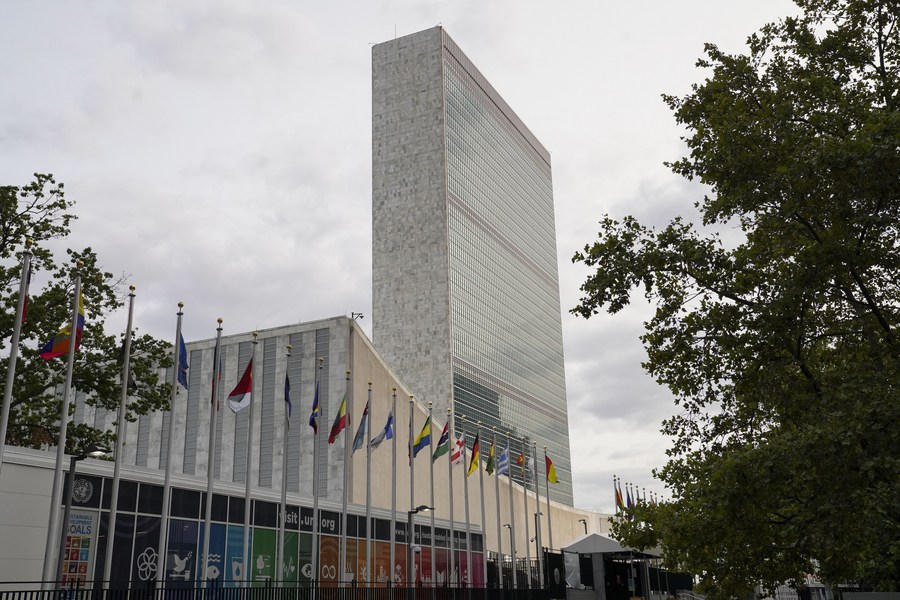
 0 Comment(s)
0 Comment(s) Print
Print E-mail Xinhua, January 10, 2025
E-mail Xinhua, January 10, 2025

Photo taken on Sept. 14, 2020 shows the outside view of the United Nations headquarters in New York, the United States. [Photo/Xinhua]
Global economic growth is projected to remain at 2.8 percent in 2025, unchanged from last year, according to a UN report released on Thursday.
Despite falling inflation, improving labor market conditions, and monetary easing, global growth is predicted to remain below the pace seen before the pandemic, and the world economy continues to face significant uncertainties, the UN World Economic Situation and Prospects 2025 report says.
The report forecasts the world economy will increase 2.9 percent in 2026.
The report says that lower inflation and ongoing monetary easing in many economies could provide a modest boost to global economic activity in 2025. However, uncertainty still looms large, with risks stemming from geopolitical conflicts, rising trade tensions and elevated borrowing costs in many countries.
These challenges are particularly acute for low income and vulnerable countries, where sub-par and fragile growth threatens to further undermine progress toward the Sustainable Development Goals (SDGs).
Growth in the United States is projected to moderate from 2.8 percent in 2024 to 1.9 percent in 2025, as labor markets soften and consumer spending slows.
Europe is expected to recover modestly, with gross domestic product (GDP) increasing from 0.9 percent in 2024 to 1.3 percent in 2025, supported by easing inflation and resilient labor markets, though fiscal tightening and long-term challenges, such as weak productivity growth and an ageing population, continue to weigh on the economic outlook.
East Asia is forecast to grow by 4.7 percent in 2025 -- driven by China's projected stable growth of 4.8 percent -- supported by robust private consumption across the region.
South Asia is expected to remain the fastest-growing region, with GDP growth projected at 5.7 percent in 2025, led by India's 6.6 percent expansion.
Africa is forecast to grow modestly from 3.4 percent in 2024 to 3.7 percent in 2025, thanks to recoveries in major economies including Egypt, Nigeria, and South Africa.
Despite continued expansion, the global economy is projected to grow at a slower pace than the 2010-2019 (pre-pandemic) average of 3.2 percent, the report says. "This subdued performance reflects ongoing structural challenges such as weak investment, slow productivity growth, high debt levels, and demographic pressures."
Global inflation is projected to decline from 4 percent in 2024 to 3.4 percent in 2025, providing some relief to households and businesses. Major central banks are expected to further cut interest rates this year as inflationary pressures continue to ease.
Yet, inflation in many developing countries is expected to remain above recent historical averages, with one in five projected to face double-digit levels in 2025.
In particular, food inflation remains elevated, with nearly half of developing countries experiencing rates above 5 percent in 2024. "This has deepened food insecurity in low income countries," the report warns.
For developing economies, easing global financial conditions could help reduce borrowing costs, but access to capital remains uneven, according to the report. Many low-income countries continue to grapple with high debt-servicing burdens and limited access to international financing.
The report emphasizes that governments should seize any fiscal space created by monetary easing to prioritize investments in sustainable development, especially in critical social sectors.
The report calls for bold multilateral action to address the interconnected crises of debt, inequality, and climate change.
"Monetary easing alone will not be sufficient to reinvigorate global growth or bridge widening disparities. Governments must avoid overly restrictive fiscal policies and instead focus on mobilizing investments in clean energy, infrastructure, and critical social sectors such as health and education," it says.